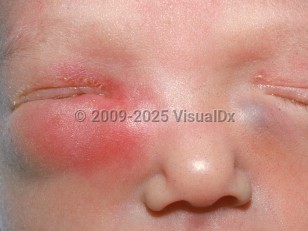Emergency: requires immediate attention
Neonatal dacryocystitis - External and Internal Eye
Alerts and Notices
Important News & Links
Synopsis

This summary discusses dacryocystitis in neonates. Dacryocystitis in adults and children is addressed separately.
Neonatal dacryocystitis is a special type of dacryocystitis that occurs in less than 1% of all newborns. The onset is usually acute, and the neonate has a swollen mass in the inferior medial canthal area. Often, there is tearing and a mucopurulent discharge. Significant morbidity and even mortality can be associated with this condition. However, the usual course is more indolent with chronic tearing, mattering, failure to thrive, and even amblyopia. Due to anatomic differences, individuals of African descent are less likely to develop the condition. Although incomplete canalization of the nasolacrimal duct is often the basis for this condition, neonatal infection can also be causative.
Neonatal dacryocystitis is a special type of dacryocystitis that occurs in less than 1% of all newborns. The onset is usually acute, and the neonate has a swollen mass in the inferior medial canthal area. Often, there is tearing and a mucopurulent discharge. Significant morbidity and even mortality can be associated with this condition. However, the usual course is more indolent with chronic tearing, mattering, failure to thrive, and even amblyopia. Due to anatomic differences, individuals of African descent are less likely to develop the condition. Although incomplete canalization of the nasolacrimal duct is often the basis for this condition, neonatal infection can also be causative.
Codes
ICD10CM:
P39.1 – Neonatal conjunctivitis and dacryocystitis
SNOMEDCT:
23735003 – Neonatal dacryocystitis
P39.1 – Neonatal conjunctivitis and dacryocystitis
SNOMEDCT:
23735003 – Neonatal dacryocystitis
Look For
Subscription Required
Diagnostic Pearls
Subscription Required
Differential Diagnosis & Pitfalls

To perform a comparison, select diagnoses from the classic differential
Subscription Required
Best Tests
Subscription Required
Management Pearls
Subscription Required
Therapy
Subscription Required
References
Subscription Required
Last Updated:12/12/2016
Emergency: requires immediate attention
Neonatal dacryocystitis - External and Internal Eye

